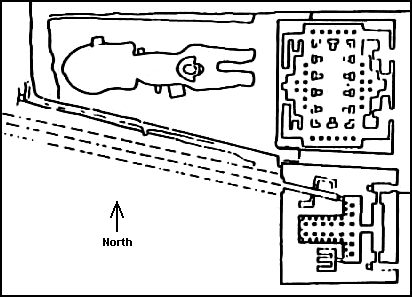Mudpuppy
Member
Ancient Egyptian Mysteries
The Great Sphinx on the Giza Plateau was not built, but rather carved from the limestone bedrock. Conventional techniques of dating the Sphinx have included analysis of its stylistic features, the stratigraphy of artifacts excavated, and the record of extant historical documentation. In my opinion, the most compelling evidence that the Sphinx dates to the time of Khafre is found in the layout of the Sphinx enclosure (see diagram below). If we assume that the Sphinx was carved in Pre-Dynastic times, then we might well wonder why the southern wall of the enclosure was carved at an angle. Why wasn't it squared with the axis of the Sphinx as were the other walls? Further, if it is assumed that the southern wall was capriciously carved at the angle we find it, then isn't it a bit too much to expect that thousands of years later, after the construction of tombs and pyramids on the surrounding necropolis, Khafre was able to build his pyramid and his valley temple, and then have the angle of the causeway connecting the two match exactly the angle of the southern wall of the enclosure? This would have been quite a providential coincidence indeed. One might counter that perhaps the southern wall of the enclosure was at first parallel with the axis of the Sphinx and then later modified by Khafre to accommodate his causeway. But in that case, the southern wall wouldn't show the alleged "ancient" erosion pattern (see photograph below), nor would the allegedly Pre-Dynastic Sphinx Temple be off-center in relation to the Sphinx but centered in relation to the "modified" southern wall.
The walls of the Sphinx enclosure are badly weathered, and this is cited by Schoch and West as supportive of their "old-Sphinx" theory. Though the vertical fissures appear to have been the result of water, other factors may have had an influence in their formation. There may have been jointing in the parent material that may have been opened by the effects of wind-borne sand particles and temperature differentials. It could also have been that carving techniques, the use of mallets and wedges, resulted in uneven stress being applied along the cut face resulting in cracking that was augmented by both wind and water erosion. Even while sand covered the bulk of the Sphinx, following heavy rain or flooding (which still occurs today) the wet sand might well have accelerated weathering. Salt crystal exfoliation may have also played a part (for a more detailed explanation, see geologist <a href=\'http://www.catchpenny.org/augustm.html\' target=\'_blank\'><span style=\'color:#0000ff\'>August Matthusen\'s</a> rebuttal to the "old-Sphinx" theory). Paul Jordan's excellent book, Riddles of the Sphinx (New York University Press, 1998) offers a good academic overview of the controversy (pp. 145-161).
Diagrams above were cribbed (and modified) from Mark Lehner's Yale University doctorate dissertation, Archaeology of an image: The Great Sphinx of Giza, ? copyright Mark Lehner 1991.
The Great Sphinx on the Giza Plateau was not built, but rather carved from the limestone bedrock. Conventional techniques of dating the Sphinx have included analysis of its stylistic features, the stratigraphy of artifacts excavated, and the record of extant historical documentation. In my opinion, the most compelling evidence that the Sphinx dates to the time of Khafre is found in the layout of the Sphinx enclosure (see diagram below). If we assume that the Sphinx was carved in Pre-Dynastic times, then we might well wonder why the southern wall of the enclosure was carved at an angle. Why wasn't it squared with the axis of the Sphinx as were the other walls? Further, if it is assumed that the southern wall was capriciously carved at the angle we find it, then isn't it a bit too much to expect that thousands of years later, after the construction of tombs and pyramids on the surrounding necropolis, Khafre was able to build his pyramid and his valley temple, and then have the angle of the causeway connecting the two match exactly the angle of the southern wall of the enclosure? This would have been quite a providential coincidence indeed. One might counter that perhaps the southern wall of the enclosure was at first parallel with the axis of the Sphinx and then later modified by Khafre to accommodate his causeway. But in that case, the southern wall wouldn't show the alleged "ancient" erosion pattern (see photograph below), nor would the allegedly Pre-Dynastic Sphinx Temple be off-center in relation to the Sphinx but centered in relation to the "modified" southern wall.
Plan of Khafre's causeway and the Sphinx enclosure.

? Photo copyright Larry Orcutt</span>

? Photo copyright Larry Orcutt</span>
The walls of the Sphinx enclosure are badly weathered, and this is cited by Schoch and West as supportive of their "old-Sphinx" theory. Though the vertical fissures appear to have been the result of water, other factors may have had an influence in their formation. There may have been jointing in the parent material that may have been opened by the effects of wind-borne sand particles and temperature differentials. It could also have been that carving techniques, the use of mallets and wedges, resulted in uneven stress being applied along the cut face resulting in cracking that was augmented by both wind and water erosion. Even while sand covered the bulk of the Sphinx, following heavy rain or flooding (which still occurs today) the wet sand might well have accelerated weathering. Salt crystal exfoliation may have also played a part (for a more detailed explanation, see geologist <a href=\'http://www.catchpenny.org/augustm.html\' target=\'_blank\'><span style=\'color:#0000ff\'>August Matthusen\'s</a> rebuttal to the "old-Sphinx" theory). Paul Jordan's excellent book, Riddles of the Sphinx (New York University Press, 1998) offers a good academic overview of the controversy (pp. 145-161).
Diagrams above were cribbed (and modified) from Mark Lehner's Yale University doctorate dissertation, Archaeology of an image: The Great Sphinx of Giza, ? copyright Mark Lehner 1991.
